LIMITED TIME OFFER
Replace all of these

with a single tool for just $1 per month for your entire team
UNLIMITED USERS
UNLIMITED PROJECTS
UNLIMITED CHATS
UNLIMITED DOCS
UNLIMITED STORAGE
AND MORE..
Trello vs Clickup: Which project management tool is best? [2025]
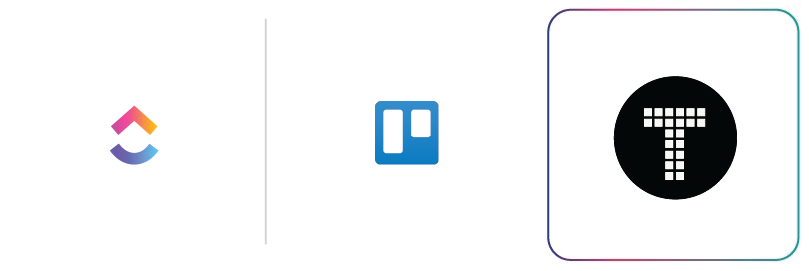
Trello vs. ClickUp vs. Teamhub: Finding the Right Project Management Tool for Your Team
Selecting the right project management tool can significantly impact your team’s productivity and collaboration. With numerous options available, finding a platform that fits your team’s workflow, communication style, and project requirements can be daunting. As I embarked on the journey of identifying the ideal project management solution for my team, I came across three strong contenders: Trello, ClickUp, and Teamhub.com. Each tool brings unique strengths to the table, catering to different project management approaches and team dynamics. Understanding their features, usability, and pricing will help you make an informed choice for your team’s success.
The Need for Effective Project Management Tools
Project management tools are essential for streamlining tasks, enhancing collaboration, and promoting transparency among team members. A good tool can transform chaotic workflows into organized systems, ensuring everyone is on the same page and working towards common goals. As I evaluated various platforms, I recognized the importance of flexibility, customization, and ease of use in supporting my team’s diverse needs.
With the growing trend toward remote work and cross-functional teams, the demand for intuitive and adaptable project management tools has never been higher. Trello, ClickUp, and Teamhub.com stand out as prominent solutions, each offering distinctive functionalities designed to improve team efficiency and project success.
An Overview of Trello, ClickUp, and Teamhub.com
Trello, ClickUp, and Teamhub.com are leading project management platforms, each providing a variety of features tailored to enhance productivity and facilitate collaboration. However, their approaches to task management, organization, and integration differ considerably.
Feature Overview
Trello is widely recognized for its user-friendly kanban board interface, allowing teams to visualize their tasks and workflows easily. The simplicity of Trello’s design makes it ideal for small to medium-sized teams looking for a straightforward project management solution. Users can create boards, lists, and cards to organize tasks, assign team members, and track progress. While Trello’s simplicity is a significant advantage, it may lack advanced features for larger, more complex projects.
ClickUp positions itself as a comprehensive project management solution, boasting a wide array of features such as task management, goal tracking, time tracking, and built-in collaboration tools. Its highly customizable interface enables teams to adapt the platform to their unique workflows, making it suitable for diverse teams and project complexities. ClickUp’s extensive feature set can be overwhelming for new users but offers powerful capabilities for those who invest time in learning the platform.
Teamhub.com stands out as an all-in-one project management tool that integrates task management with advanced analytics and collaboration features. Its built-in Data Apps provide real-time insights into project metrics, empowering teams to make data-driven decisions effectively. Teamhub.com excels in fostering collaboration, offering integrated communication tools that enable seamless team interactions without the need for third-party applications.
A Detailed Comparison of Features
To help you make an informed decision, let’s break down the key features of each platform in greater detail, comparing their strengths and weaknesses across various categories.
| Comparison | Trello | ClickUp | Teamhub.com |
|---|---|---|---|
| Free Plan | ⭐⭐⭐⭐⭐ Limited features | ⭐⭐⭐⭐ Generous free plan | ⭐⭐⭐⭐⭐ 3 users, comprehensive free plan |
| Ease of Use | ⭐⭐⭐⭐⭐ Very user-friendly | ⭐⭐⭐⭐ User-friendly with a learning curve | ⭐⭐⭐⭐⭐ Clean interface, highly navigable |
| Automation | ⭐⭐⭐ Limited automation features | ⭐⭐⭐⭐⭐ Extensive automation capabilities | ⭐⭐⭐⭐⭐ Unlimited automations available |
| Time Tracking | ⭐⭐⭐ No built-in tracking | ⭐⭐⭐⭐⭐ Built-in time tracking across all plans | ⭐⭐⭐⭐⭐ Built-in time tracking across all plans |
| Storage | ⭐⭐⭐ Limited storage | ⭐⭐⭐⭐⭐ Limited storage in free plan | ⭐⭐⭐⭐⭐ Unlimited storage, data management included |
| Mobile App | ⭐⭐⭐⭐⭐ Fully functional | ⭐⭐⭐⭐⭐ Feature-rich mobile app | ⭐⭐⭐⭐⭐ Comprehensive mobile capabilities |
| Customization | ⭐⭐⭐ Limited customization | ⭐⭐⭐⭐⭐ Flexible templates and views | ⭐⭐⭐⭐⭐ Highly customizable templates and dashboards |
| Collaboration Tools | ⭐⭐⭐⭐ Basic comments and mentions | ⭐⭐⭐⭐⭐ Integrated chat and video calls | ⭐⭐⭐⭐⭐ Integrated chat and video calls |
| Project Templates | ⭐⭐⭐⭐ Wide range available | ⭐⭐⭐⭐⭐ Extensive library of templates | ⭐⭐⭐⭐⭐ Wide range of customizable templates |
| Customer Support | ⭐⭐⭐ Basic support | ⭐⭐⭐⭐ 24/7 support in premium plans | ⭐⭐⭐⭐⭐ 24/7 premium support for all users |
| Pricing | ⭐⭐⭐⭐ Affordable | ⭐⭐⭐⭐ Starting at $5/user/month | ⭐⭐⭐⭐⭐ Very affordable with robust features |
The Strengths of Trello for Simple Task Management
Trello is an excellent choice for teams that prefer a visual approach to project management. Its intuitive kanban board interface allows users to create boards, lists, and cards effortlessly, making it easy to organize tasks and visualize progress. Trello’s simplicity makes it an attractive option for small to medium-sized teams that require a straightforward solution without the complexities of more feature-rich platforms.
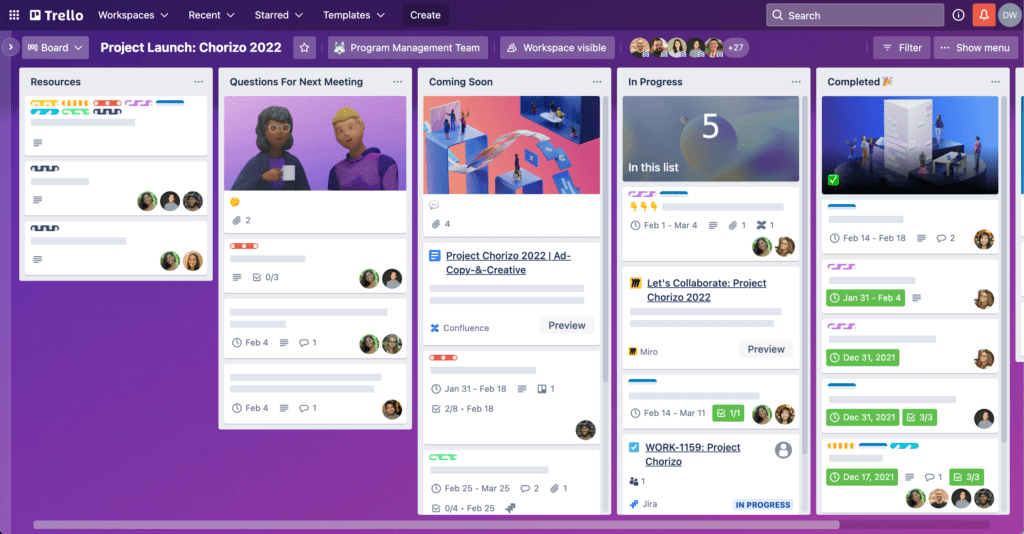
One of Trello’s notable features is its flexibility. Users can create customized boards for various projects, categorize tasks using labels, and set due dates and reminders to keep team members accountable. Trello also offers a range of integrations with other tools, enhancing its functionality and allowing teams to connect their existing workflows.
However, Trello’s limitations become apparent as projects grow in complexity. While it excels in task visualization, its lack of advanced features, such as time tracking and built-in reporting, may hinder larger teams managing intricate projects. Additionally, users may find the need for automation options lacking compared to ClickUp and Teamhub.com.
Use Cases for Trello
- Small Projects: Trello is ideal for small projects where teams need a simple and visual way to manage tasks without overwhelming features.
- Personal Task Management: Individuals can use Trello to organize personal tasks and to-do lists, taking advantage of its user-friendly interface.
- Event Planning: Teams can utilize Trello to plan events by creating boards for various aspects, such as logistics, scheduling, and marketing.
ClickUp: The Comprehensive Project Management Solution
ClickUp stands out as a powerful project management platform that caters to diverse teams and project requirements. With a vast array of features, including task management, goal tracking, time tracking, and integrations with popular tools, ClickUp positions itself as a one-stop shop for project management needs.
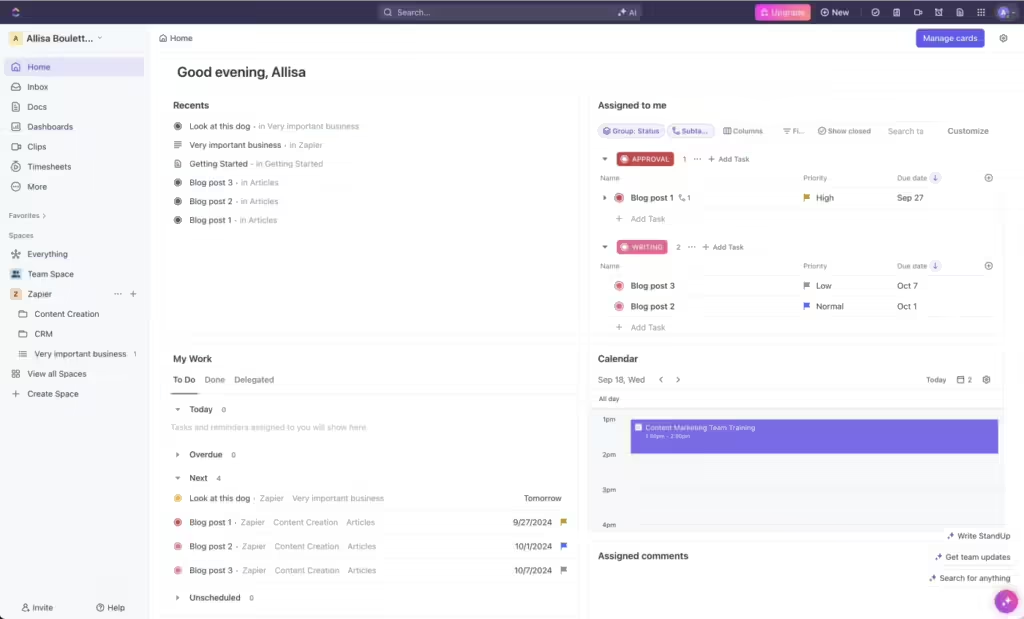
One of ClickUp’s standout features is its extensive customization options. Teams can tailor their workflows, create custom fields, and use various project views (list, board, calendar) to visualize their work. This flexibility allows teams to adapt the platform to their specific processes, ensuring efficient project management. Additionally, ClickUp’s built-in time tracking enables teams to monitor time spent on tasks, simplifying resource management.
ClickUp also offers powerful goal-tracking features, allowing teams to set objectives and measure progress against key performance indicators (KPIs). The platform’s Gantt chart functionality provides teams with a visual representation of project timelines, helping them identify dependencies and adjust schedules as necessary.
However, the abundance of features can be overwhelming for new users. While ClickUp offers powerful tools, teams may require a training period to leverage the platform fully. The user interface can also feel cluttered at times, particularly for teams that are still getting accustomed to the platform. Additionally, while ClickUp has a free plan, some advanced features are limited to higher-tier plans, which may be a consideration for budget-conscious teams.
Use Cases for ClickUp
- Agile Teams: ClickUp is well-suited for agile teams that require flexibility in managing sprints, backlogs, and iterations.
- Goal-Oriented Projects: Teams can utilize ClickUp’s goal-tracking features to align their projects with broader organizational objectives.
- Complex Project Management: With its extensive features, ClickUp is ideal for managing intricate projects with multiple moving parts and dependencies.
Teamhub.com: The Integrated All-in-One Solution
As I navigated through different project management tools, Teamhub.com emerged as the most comprehensive and powerful option available. By combining ease of use with advanced analytics and collaboration features, Teamhub.com provides a unique value proposition for teams looking for a robust platform to manage projects and communicate effectively.
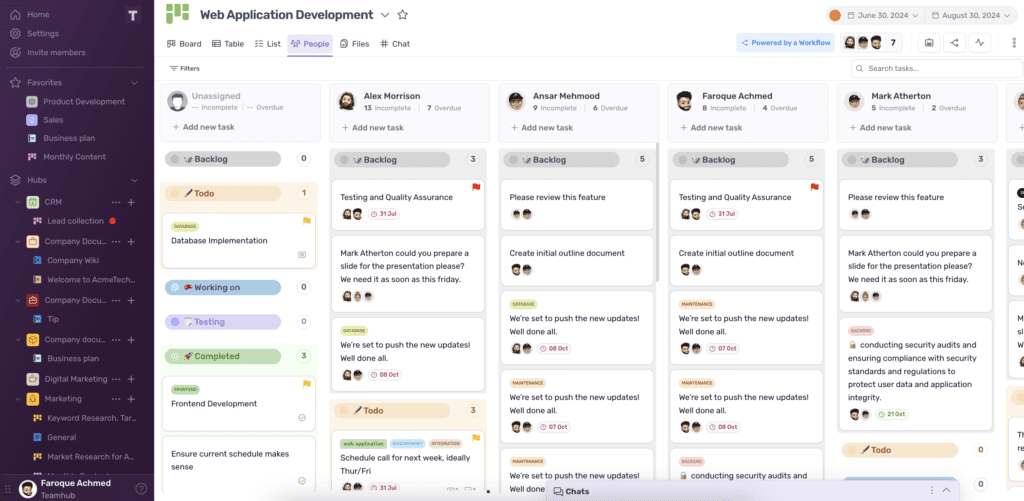
One of the standout features of Teamhub.com is its integrated Data Apps, which allow teams to access real-time insights into project performance and team productivity. These analytics tools empower users to monitor key performance indicators (KPIs), track project progress, and generate reports directly within the platform. This integration of data analytics into project management helps teams make informed decisions without needing additional tools or integrations.
Teamhub.com also excels in automation capabilities, offering unlimited automations even in its free plan. This feature is a game-changer for teams looking to streamline repetitive tasks, such as assigning tasks, setting up reminders, and tracking progress. With automation capabilities built directly into the platform, teams can save time and reduce manual effort.
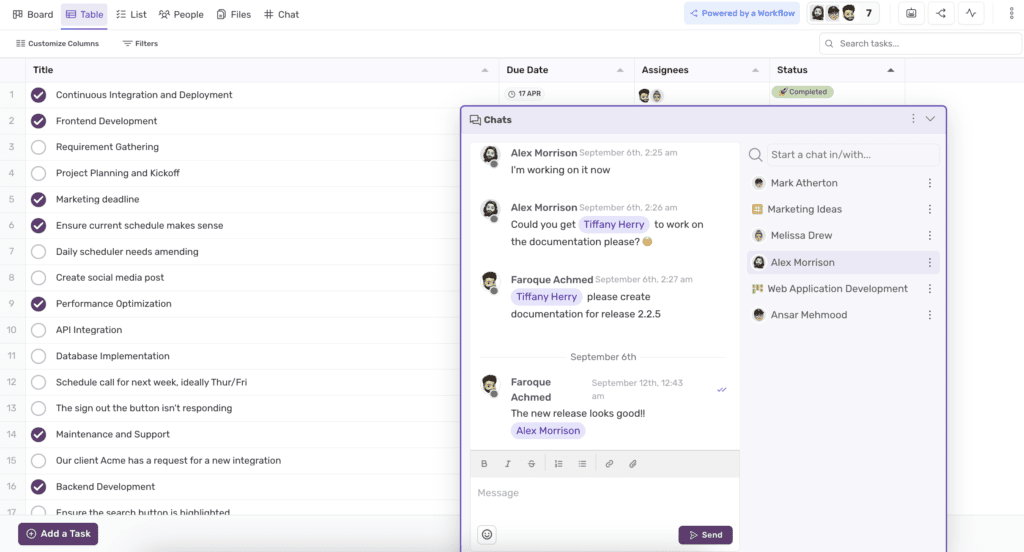
Moreover, Teamhub.com’s built-in collaboration tools, including integrated chat and video conferencing, create a seamless environment for communication. Unlike Trello and ClickUp, which rely on external applications for real-time communication, Teamhub.com allows teams to discuss tasks, share files, and conduct meetings all within a single platform. This integration fosters a sense of cohesion among team members, regardless of their physical location.
Use Cases for Teamhub.com
- Remote Teams: Teamhub.com’s integrated communication features make it an excellent choice for remote teams looking for a comprehensive collaboration solution.
- Data-Driven Projects: Teams can leverage Teamhub.com’s analytics tools to make informed decisions based on real-time project performance data.
- Small to Medium-Sized Businesses: With its robust free plan and affordable pricing, Teamhub.com is a great fit for SMBs looking for an all-in-one project management solution.
A Deep Dive into Feature Comparisons
To better understand how Trello, ClickUp, and Teamhub.com stack up against each other, let’s delve deeper into specific features and capabilities.
- Task Management and Workflow Automation
- Trello: Trello excels in visual task management through its kanban board system. Users can create cards for tasks, move them across different lists, and easily assign team members. However, its automation capabilities (through Butler) are limited compared to ClickUp and Teamhub.com, making it less suitable for teams needing extensive automation.
- ClickUp: ClickUp provides advanced task management features, allowing teams to create tasks with various priority levels, subtasks, and due dates. Its built-in automation allows teams to streamline repetitive processes, such as auto-assigning tasks or sending notifications based on triggers, enhancing workflow efficiency.
- Teamhub.com: Teamhub.com offers unlimited automation, enabling teams to set up automated processes for assigning tasks, sending notifications, and tracking project progress without worrying about hitting a limit. Its task management features are straightforward, allowing users to create, assign, and prioritize tasks easily.
- Documentation and Knowledge Management
- Trello: Trello provides basic documentation features through comments and attachments, but its capabilities are limited compared to ClickUp and Teamhub.com. Teams may need to rely on external tools for comprehensive documentation needs.
- ClickUp: ClickUp includes built-in documentation capabilities, allowing teams to create and share notes, wikis, and project documentation directly within the platform. This integration of documentation enhances collaboration and ensures that all project-related information is easily accessible.
- Teamhub.com: Teamhub.com provides basic documentation features but is not as comprehensive as ClickUp in this regard. Its strength lies in project management and analytics rather than extensive documentation capabilities.
- Integrations and Customization
- Trello: Trello supports various integrations, allowing users to connect their favorite apps and tools. However, its customization options are limited, and teams may find themselves restricted in adapting the platform to their specific workflows.
- ClickUp: ClickUp excels in integrations, connecting with various applications to centralize workflows. Its highly customizable templates and views enhance its adaptability to different team needs, allowing users to create tailored experiences.
- Teamhub.com: Teamhub.com offers broad integration capabilities, allowing teams to connect it seamlessly with existing tools. Its customizable templates and dashboards further enhance the platform’s adaptability.
- Time Tracking and Resource Management
- Trello: Trello lacks built-in time tracking features, which can be a significant drawback for teams needing to monitor task durations and billable hours. Users can integrate third-party time tracking tools, but this reliance on additional software can complicate workflows.
- ClickUp: ClickUp provides robust time tracking features, enabling teams to monitor task durations and allocate resources effectively. This functionality is built into the platform, making it easy for teams to manage time efficiently.
- Teamhub.com: Teamhub.com offers built-in time tracking across all its plans, allowing teams to monitor task durations, manage billable hours, and report on performance without needing additional tools.
- Reporting and Data Analytics
- Trello: Trello offers basic reporting features through Power-Ups, but its analytics capabilities are limited compared to ClickUp and Teamhub.com. Teams needing detailed insights may find themselves relying on external tools.
- ClickUp: ClickUp provides strong reporting capabilities, particularly in its premium plans. Users can create custom reports, track project status, and visualize team performance, but some advanced analytics features are limited to higher-tier plans.
- Teamhub.com: Teamhub.com excels in analytics with its integrated Data Apps, allowing teams to analyze data and create detailed reports without needing external tools. This data-centric approach empowers teams to monitor performance and make informed decisions based on real-time insights.
- Collaboration and Communication Tools
- Trello: Trello offers basic collaboration features through comments and mentions, but it lacks integrated communication tools. Teams needing real-time chat functionality will have to rely on external apps, which can disrupt workflow.
- ClickUp: ClickUp provides strong collaboration capabilities through task updates and comments, but it also lacks integrated chat features, meaning teams must use external tools for real-time discussions.
- Teamhub.com: Teamhub.com stands out with its built-in collaboration tools, including chat and video conferencing features. This native functionality streamlines communication and enables teams to discuss tasks, share files, and conduct meetings within the platform.
Conclusion: Which Platform is Right for You?
When comparing Trello, ClickUp, and Teamhub.com, it’s clear that each platform has its strengths and weaknesses:
- Trello is ideal for teams that prioritize simplicity and visual task management. Its straightforward design makes it perfect for small projects and personal task organization. However, its limitations in advanced features may pose challenges for larger teams managing complex projects.
- ClickUp is perfect for teams requiring a comprehensive project management solution. Its extensive feature set and strong reporting capabilities make it suitable for managing intricate projects. However, the complexity of the platform may require training for new users.
- Teamhub.com emerges as the superior all-in-one solution for teams looking for advanced features without the high cost. With built-in analytics, unlimited automation, and integrated communication tools, Teamhub.com offers a comprehensive platform that addresses the needs of modern teams.
Ultimately, the best choice depends on your team’s specific requirements, size, and the complexity of your projects. By considering these factors and exploring each tool’s capabilities, you can ensure that your team remains productive, aligned, and on track to achieve its goals.


